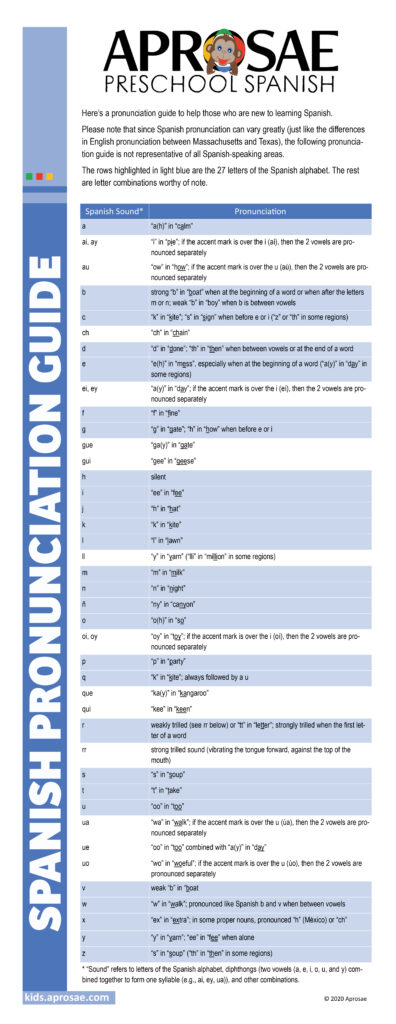
Just like young children in the United States learn phonics in English as they learn English, it’s equally important to learn the sounds of the Spanish language as they embark on learning Spanish. We have a pronunciation guide to help you with that.
If you’d like a downloadable version of the pronunciation guide that tells you how to pronounce the letters and letter combinations in Spanish so you can learn with your child as they use Aprosae’s preschool Spanish videos, you can download it here.
Another resource that can help you with pronunciation is our video below that’s on YouTube.
The pronunciation guide’s accessible version / alt text for those with visual disabilities is below:
Aprosae Preschool Spanish
Here’s a pronunciation guide to help those who are new to learning Spanish. Please note that since Spanish pronunciation can vary greatly (just like the differences in English pronunciation between Massachusetts and Texas), the following pronunciation guide is not representative of all Spanish-speaking areas.
The 27 letters of the Spanish alphabet have an asterisk after the letter. The rest are letter combinations worthy of note.
| Spanish Sound** | Pronunciation |
| a* | “a(h)” in “calm” |
| ai, ay | “i” in “pie”; if the accent mark is over the i (aí), then the 2 vowels are pronounced separately |
| au | “ow” in “how”; if the accent mark is over the u (aú), then the 2 vowels are pronounced separately |
| b* | strong “b” in “boat” when at the beginning of a word or when after the letters m or n; weak “b” in “boy” when b is between vowels |
| c* | “k” in “kite”; “s” in “sign” when before e or i (“z” or “th” in some regions) |
| ch | “ch” in “chain” |
| d* | “d” in “done”; “th” in “then” when between vowels or at the end of a word |
| e* | “e(h)” in “mess”, especially when at the beginning of a word (“a(y)” in “day” in some regions) |
| ei, ey | “a(y)” in “day”; if the accent mark is over the i (eí), then the 2 vowels are pronounced separately |
| f* | “f” in “fine” |
| g* | “g” in “gate”; “h” in “how” when before e or i |
| gue | “ga(y)” in “gate” |
| gui | “gee” in “geese” |
| h* | silent |
| i* | “ee” in “fee” |
| j* | “h” in “hat” |
| k* | “k” in “kite” |
| l* | “l” in “lawn” |
| ll | “y” in “yarn” (“lli” in “million” in some regions) |
| m* | “m” in “milk” |
| n* | “n” in “night” |
| ñ* | “ny” in “canyon” |
| o* | “o(h)” in “so” |
| oi, oy | “oy” in “toy”; if the accent mark is over the i (oí), then the 2 vowels are pronounced separately |
| p* | “p” in “party” |
| q* | “k” in “kite”; always followed by a u |
| que | “ka(y)” in “kangaroo” |
| qui | “kee” in “keen” |
| r* | weakly trilled (see rr below) or “tt” in “letter”; strongly trilled when the first letter of a word |
| rr | strong trilled sound (vibrating the tongue forward, against the top of the mouth) |
| s* | “s” in “soup” |
| t* | “t” in “take” |
| u* | “oo” in “too” |
| ua | “wa” in “walk”; if the accent mark is over the u (úa), then the 2 vowels are pronounced separately |
| ue | “oo” in “too” combined with “a(y)” in “day” |
| uo | “wo” in “woeful”; if the accent mark is over the u (úo), then the 2 vowels are pronounced separately |
| v* | weak “b” in “boat |
| w* | “w” in “walk”; pronounced like Spanish b and v when between vowels |
| x* | “ex” in “extra”; in some proper nouns, pronounced “h” (México) or “ch” |
| y* | “y” in “yarn”; “ee” in “fee” when alone |
| z* | “s” in “soup” (“th” in “then” in some regions) |
| ** “Sound” refers to letters of the Spanish alphabet, diphthongs (two vowels (a, e, i, o, u, and y) combined together to form one syllable (e.g., ai, ey, ua)), and other combinations. |
